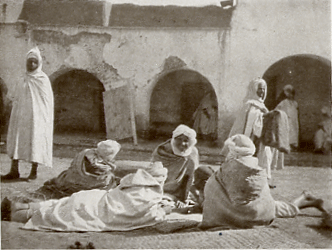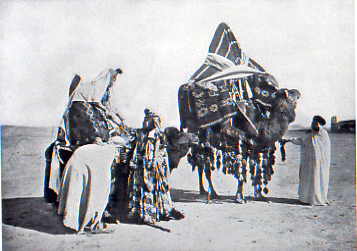
Outside a café: Biskra
A century brings change, yet memories of the past can still bring life to a quickly forgotten past. Exactly one hundred years ago, if you were to visit your doctor and pick up the latest issue of National Geographic Magazine, you would find a story about Biskra, the oasis in Algeria. Pre-Valentino’s The Sheik, this is rather pedestrian travel dialogue from an author who survives in the text only as a Mrs. But the pictures are truly marvelous and make returning to this century-old magazine well worthwhile. Webshaykh
A visit to the market place during the morning is one of the sights of the town and oriental in every tone. Squatting groups and bronzed-legged Bedouins, in brown and white camel’s-hair burnouses, are selling cous-cous, dried peppers, and of course dates. Bunches of fresh grass and green barley and thistles are heaped in one corner of the inclosure, Moorish slippers here and a pile of red fezzes there, and souvenirs for the tourist not lacking. For fifty centimes one may purchase a set of graceful gazelle horns, and curious knives and Arabian guns tempt the collector on the way. An ebon negress is selling oranges, an Arab boy in a red fez, and not much else, carries a basket of purple fruit in green leaves, while cloaks, burnouses, turbans, and yakmahs, purple, blue, deep red, and spotless white all crushed together, make a kaleidoscopic color in the whitewashed square. Bags of henna leaves, for staining the nails in Arab fashion, send forth their pungent odor, and the aroma of coffee and cigarettes fills the air. A Kabyle girl in red gown, tattooed bluely as to her forehead and cheeks, stained yellow as to her finger tips, passes us, cigarette in mouth, her bangles and anklets clanking as she goes.
Outside a Moorish café a row of Moors, clean in their white burnouses, are solemnly crouched, two of them playing a grave game of chess, but the rest doing nothing to perfection, without a trace of boredom or a gesture of impatience, a state of dreamy delight achieved apparently by habit of mind, a realization of Arabian Keyf. Two merry cantinières go briskly along, and behind them glide two Sisters of Charity. Occasionally a tall figure in white burnouse and dark blue or pale gray cape, with crimson fez and gold-embroidered jacket, passes, and the dark eyes and white teeth flash down in friendly glance. Occasionally, too, there is a suspicion of genuine attar-of-rose whiffed in the air, as one of this oriental jeunesse dorée walks by us, and we are reminded of what an Arabian courier once told us: “On my country, if a man have perfume on his clothes, it makes scandal!â€â€¦

Ships of the Desert
Beautiful Biskra with her crown of palms rises before us in the sunset as we approach. The grace, lightness, and yet the suggestive strength of the wonderful trees is difficult to describe; the glow of sunset on the stems, the shadows of the sharp-pointed leaves, all need a subtler pen than mine. The sands are dyed deep purple now, with high lights of brilliant rose, and over the Sahara bends the evening sky, its blue blending into saffron and green, washed thinly with streaks of crimson. Until one has seen the sun go down over the African desert one can never conceive what brightness of color Nature carries on her palette.
[Excerpts from Mrs. George C. Bosson, Jr, “Biskra, the Ziban Queen“ National Geographic Magazine 19(8):563-593, 1908.]